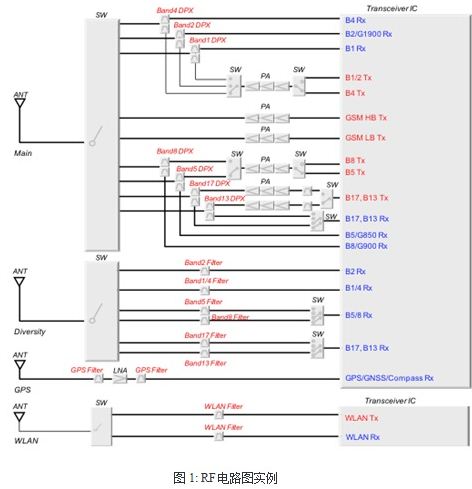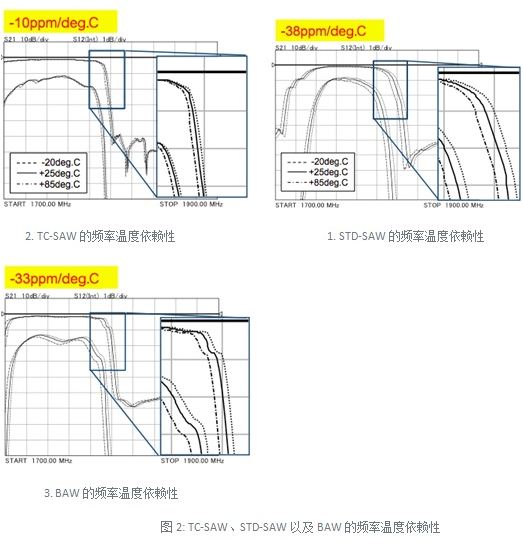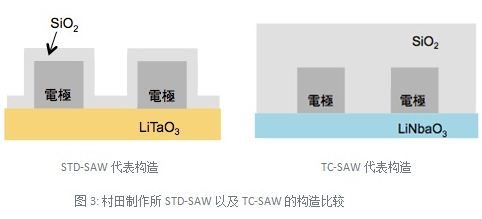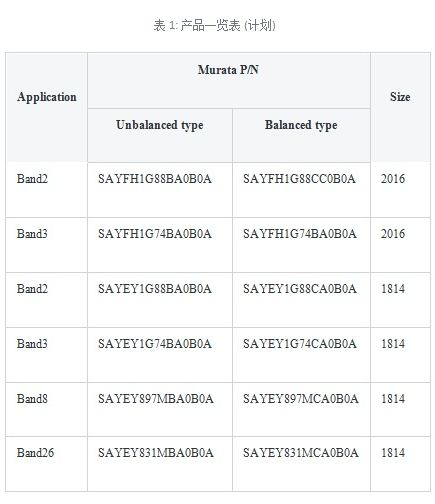In recent years, with the spread of multi-function terminals such as smartphones and tablets equipped with high-performance processors, the surge in information in the field of wireless communication has become a major issue. In response to this problem, the communication industry has adopted the method of Long Term Evolution (LTE) of the second generation communication specification, and the frequency band operation method of this frequency has not been used in mobile devices.
In addition, the number of components in the Radio Frequency (RF) circuit corresponding to the new frequency is correspondingly increased. The specifications of the original Global System for Mobile Communication (GSM) / Universal Mobile Telecommunications System (UMTS)-compatible terminals are four in GSM, and two in UMTS, and many in LTE-compatible terminals. 1-2 bands. For mobile phone manufacturers, in order to be able to carry more components in a limited space like mobile devices, it is necessary to install components by modularizing and densifying electronic components, and then the board generates heat. The deterioration and the temperature increase caused by the proximity to the heating element are problems that cannot be avoided by the components inside the device.
This chapter introduces the countermeasures developed by Murata to solve the problem of temperature rise in mobile devices. This is the Temperature Compensated-Surface Acoustic Wave (TC-SAW) with the feature of reducing the frequency shift of temperature changes.
SAW duplexer operation and problems
The Surface Acoustic Wave (SAW) duplexer for filtering frequency is one of the electronic components that contribute to the miniaturization, multi-functionality and diversification of mobile phones because of its miniaturization and wide selection.
First, we will briefly explain how the SAW duplexer works in the actual operation of the RF circuit. Figure 1 is a typical RF circuit diagram. The frequency at which the signal is received by Antenna (Ant) at the time of receiving is switched to the appropriate SAW duplexer through the Switch (SW), filtered by the SAW duplexer to the necessary frequency, and then transmitted to the Transceiver-Integrated Circuit (Transceiver- IC). The high-frequency signal generated from the Transceiver-IC at the time of transmission is amplified by the Power Amplifier (PA), and then filtered by the SAW duplexer to a necessary frequency to transmit a signal from the Ant to the base station. In addition, the SAW duplexer can also prevent the rotation of the transmission signal generated from the transmission circuit to the receiving circuit during transmission.
It is necessary for the SAW duplexer to generate an amplified signal power through the PA during transmission, and it is necessary to transmit to the Ant more efficiently, and at this time, the relationship of the SAW duplexer causes loss of signal power. The lost signal power is converted into thermal energy and the SAW duplexer itself heats up. In addition, as the number of corresponding frequency bands increases, the influence of the modularization and high-density mounting on the heat-generating components such as PA is increased. Therefore, the SAW duplexer takes into account temperature variations in the RF circuitry used by mobile devices, and it has already factored a range of temperature variations. The problem that must be considered at this point is that the temperature change of the SAW duplexer causes a change in frequency. This frequency change is a problem that the SAW duplexer has to consider in the corresponding temperature rise problem in the RF circuit.

Comparison of frequency temperature dependence of TC-SAW, STD-SAW and BAW
The solution proposed for this problem is expected to become a technique for reducing frequency temperature dependence in recent years. Murata has developed a product TC-SAW that reduces frequency-temperature dependence using a unique technology, in addition to Standard (STD)-SAW.
In addition, in recent years, the Bulk Acoustic Wave (BAW) technology in the market has become a technique of rapid increase in the sense of frequency by good frequency selectivity and high frequency correspondence. Various frequency temperature dependences will be compared below.
Fig. 2 is an example of frequency-temperature dependence of TC-SAW, STD-SAW and general BAW which are being produced by Murata Manufacturing Co., Ltd. The ppm/deg. C shown in Fig. 2 indicates the ratio of the frequency change when the temperature changes. This value shows that the dependence is extremely small in the case of a slight temperature change. The value of STD-SAW is only -38ppm/deg. The amount of change of /4. Compared with BAW, the frequency temperature dependence of BAW is about -33ppm/deg.C, and TC-SAW is almost reduced by 1/3. Based on this conclusion, it can be concluded that TC-SAW has the characteristics of optimizing frequency temperature dependence.

Construction of TC-SAW
Fig. 3 is a schematic view showing the construction of the Murata Manufacturing Co., Ltd. STD-SAW and TC-SAW. The frequency temperature dependence of the SAW duplexer is due to the use of a piezoelectric circuit board. In addition, both STD-SAW and TC-SAW have the same characteristics of frequency-temperature dependence because of the piezoelectric board used. As shown in Figure 3, one of the most representative features of TC-SAW is that the entire board is covered with a thick layer of silicon dioxide (SiO2) compared to STD-SAW. When the temperature of the piezoelectric circuit board rises, the frequency decreases, and the frequency temperature coefficient becomes a negative value. In addition, SiO2 has the characteristics of a positive frequency temperature coefficient. Therefore, compared with STD-SAW, due to the unique structure of a thick SiO2 layer, the influence of the positive frequency temperature coefficient of SiO2 becomes larger, so the SAW duplexer achieves suppression of frequency temperature dependence compared with STD-SAW. Sexual characteristics. STD-SAW's protective film SiO2 has a strong characteristic. If it is covered with SiO2 as thick as TC-SAW, the bandwidth cannot be guaranteed and excellent characteristics cannot be obtained. Therefore, TC-SAW can change the material of the board from LiTaO3 to LiNbaO3 to ensure the necessary bandwidth. In addition, the cutting angle of TC-SAW's LiNbaO3 has changed to make the frequency selectivity controllable. Murata has used the necessary characteristics of the corresponding project to design the best cutting angle to meet market demand.

Murata's TC-SAW product lineup
The design of the duplexer determines the difficulty of the transmission and reception bandwidth of the frequency band and the separation ratio of the transmission end and the reception end according to the specifications of the Third Generation Partnership Project (3GPP). Generally speaking, the wider the bandwidth of the frequency, the smaller the frequency interval between the transmitting end and the receiving end, and the higher the difficulty. Summarize the relationship between the two, as shown in Figure 4. Murata Manufacturing Co., Ltd. is working on the part circled in Figure 4, and plans to give priority to the products corresponding to TC-SAW.

The TC-SAW related products introduced so far are actually the current mainstream 2.0×1.6mm (2016) size product lineup and the 1.8×1.4mm (1814) size product lineup that will become mainstream in the future, as shown in Table 1. . These products have already started mass production and will be available to the market soon. Thanks to good feedback from customers, it is expected to expand according to market demand in the future.

Future prospects
The history of TC-SAW of Murata has been around for a long time. Since the commercialization of Band2 in 2004, many projects have been commercialized. At the same time, as the structure changes and the application improves, the market demand for miniaturization and high performance is continuously met. In the future, the expectation of TC-SAW will be higher with the trend of higher density of RF circuits. In the meantime, Murata will continue to expand its product lineup using the technology introduced and continue to develop new and improved TC-SAW products. In addition, in order to respond to the modularization trend of RF circuits, it is expected to expand the product lineup for modules.
Langrui Energy (Shenzhen) Co.,Ltd , https://www.langruienergy.com